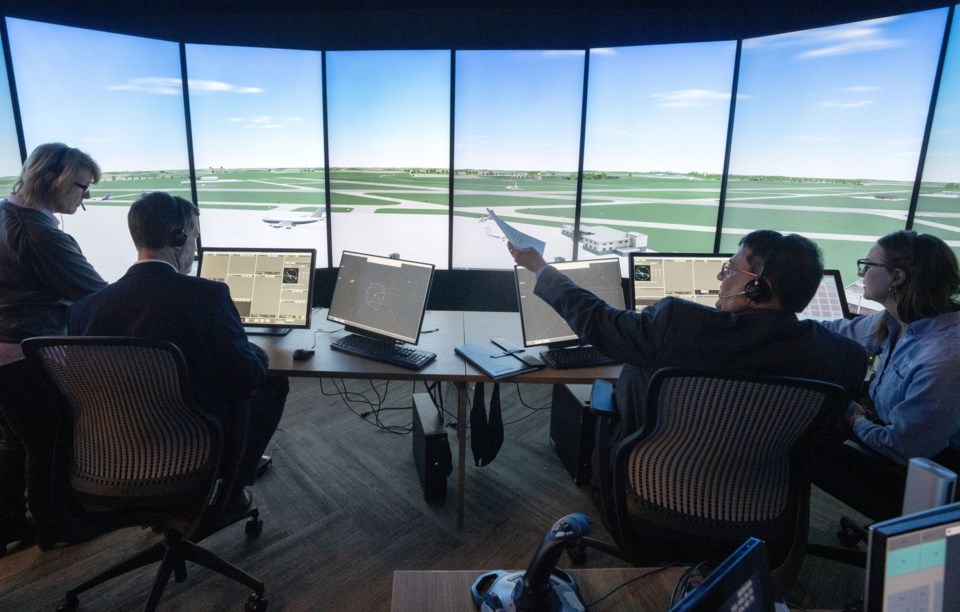MONTREAL — An airplane engulfed in flames scorches across the farmland horizon, trailing smoke as it plummets toward an airport runway — leaving those inside the control tower with seconds to react.
“There's a mayday situation,” barks air traffic instructor Karina Vasylenko, compelling a second aircraft to pull up.
A code-laced back-and-forth between tower and ground control follows. Emergency vehicles race onto the taxiway and the space becomes clear for landing.
“Runway two-seven is yours for the emergency,” confirms a fellow instructor.
The simulation, which played out Tuesday on a bank of screens the size of bus ads, is one of many scenarios to be thrown at the first crop of students at CAE Inc.’s new air traffic training centre in Montreal.
Amid a severe labour shortage and concerns around flight safety oversight, the company has joined the effort to churn out more air traffic controllers. The move expands its wheelhouse beyond pilots and maintenance technicians to include trainees bound for control towers.
The goal is to sharply increase the number of graduates and take on 478 air traffic students by 2028, drawing on courseware from Nav Canada, the non-profit body that runs the country’s civil air navigation as well as seven schools across the country. CAE, the world’s largest maker of flight simulators, signed an agreement with Nav Canada last April to help train controllers and flight service specialists.
Air traffic controllers shepherd pilots to and from airports, instructing them to climb, descend or taxi in quick succession. From towers and windowless "area control centres," they monitor 18 million square kilometres of airspace through a complex array of maps, radar and weather data.
“Sometimes, you’re playing the role of a traffic cop on a freeway,” said CAE flight centre head Stella Hughes.
A shortage of these sky cops, however, has serious implications for employee stress and passenger safety. Meanwhile, an aging workforce, rising flight activity and a timeline that can top two years to train new recruits make the problem even trickier.
“The need is very urgent,” Hughes said, speaking from CAE’s airport-adjacent headquarters in Montreal.
The process to become an air traffic professional is among the longest in aviation, topped only by pilots and a few other specialized jobs. The role demands between 10 and 27 months of training. Parental leave or a move to a new airport mean months of retraining.
“It’s not just a labour shortage, but it’s more air travel as well,” Hughes said, referring to increasingly crowded skies. “You either deal with that with technology and being able to be more responsive, or you deal with that by bringing on additional staff.”
At Nav Canada, the graduation rates for air traffic controllers sit at about 40 per cent, said chief human resources officer Diana Kelly. It’s 76 per cent for flight service specialists, who play a support role by relaying information on weather conditions to pilots.
“Unfortunately, not everyone is cut out to be an ATC (air traffic controller),” said Nav Canada spokeswoman Vanessa Adams. The job demands spatial awareness, memorization of codes and call signs, clear communication and calm during emergencies when lives are on the line.
“It’s meant to be hard.”
Nav Canada hopes to take on about 1,500 students by 2028, adding to the roughly 2,500 air traffic controllers and flight service specialists it employs now, Adams said.
“It was bad, and it is bad,” said Nick von Schoenberg, president of the Canadian Air Traffic Control Association, referring to the shortage. He pointed in particular to an impending wave of retirements.
“We have a fairly old workforce ... However, we’re making some progress,” the union head said in a phone interview. “There has been a really concerted effort made by the company to address this.”
The COVID-19 pandemic prompted many to take retirement packages, but also stymied preparation of new recruits due to social distancing and the drastic decrease in flight volumes.
"It was very difficult to continue our training in a meaningful way because we had such a major drop in our traffic levels. So then our students were not exposed to enough air traffic to finish their training," said Kelly.
In 2023, the International Air Transport Association called out air traffic control organizations in North America, including Nav Canada, for staffing shortages that caused what it called “unacceptable delays and disruptions" to flights.
That December, Canada received a C grade on flight safety oversight — down from an A+ almost two decades earlier and far below most of its peers — according to a draft report from a United Nations agency.
The confidential audit from the International Civil Aviation Organization obtained by The Canadian Press highlighted air navigation among three areas of concern in the sector. Alongside other measures, it recommended the federal government ensure proper training and fatigue management for air traffic controllers.
“The lack of staff does put pressure and stress on the workforce,” von Schoenberg said. “That in itself can indirectly affect the margin of safety.”
At least one big incentive to attract fresh talent stands out. Air traffic controllers earn a baseline salary of between $133,000 and $194,000, said Kelly. Income can top $250,000 with overtime — in high demand at some airports amid the dearth of staff. Students earn more than $54,000 a year.
This report by The Canadian Press was first published Jan. 16, 2025.
Companies in this story: (TSX:CAE)
Christopher Reynolds, The Canadian Press



